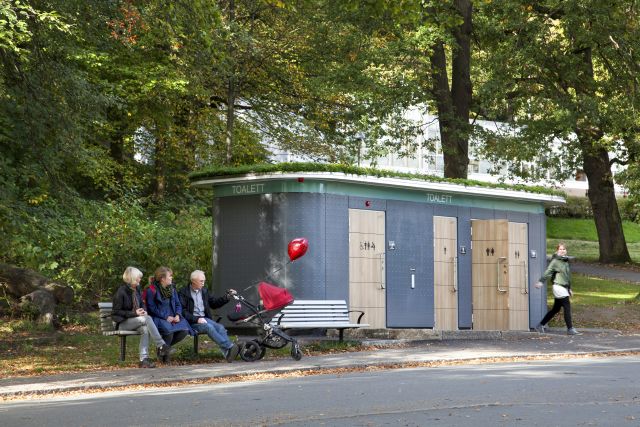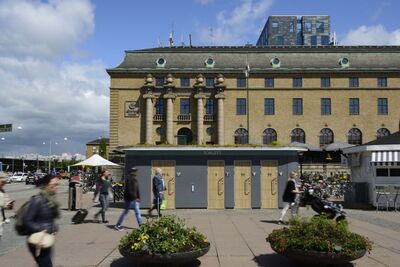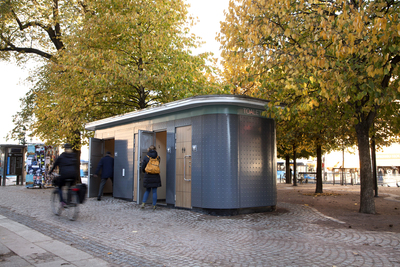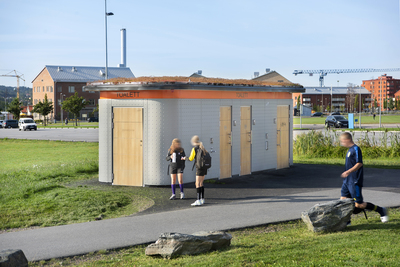
Access to public toilets is an equality issue
In Great Britain, local authorities are not required by law to provide public toilets, and closing a public toilet may seem like an opportunity to cut costs in a time of budget constraints. But according to Suzanne Audrey, research fellow in public health at the University of Bristol, public toilets should be considered in the broader context of economic well-being, life quality, public health and inclusiveness.
We addressed this issue in a previous article “Public toilets for a more equal city”, which noted that Swedish studies show that modern public toilets in public spaces represent a safe, welcoming place. The studies show that the availability of public toilets enables more visitors to come to a place and stay there longer. This is especially true of women, families and the elderly.

Lack of public toilets – what are the consequences?
In a recent article, Suzanne Audrey identifies some of the consequences that result from a lack of public toilets:
- Fouling of the streets
- A lack of public toilets encourages fouling of public spaces. This was illustrated during the pandemic restrictions in Great Britain, when the closure of public toilets and businesses led to a growing number of people seeing to their needs in the streets, parks and other public spaces. Cleaning up after them is an unpleasant and expensive job for local authorities.
- A lack of public toilets encourages fouling of public spaces. This was illustrated during the pandemic restrictions in Great Britain, when the closure of public toilets and businesses led to a growing number of people seeing to their needs in the streets, parks and other public spaces. Cleaning up after them is an unpleasant and expensive job for local authorities.
- Uncomfortable and unhygienic for children
- Children have less control over their bladders and often find themselves in a hurry to find a toilet. If no public toilet is available, the choice is either to go home or find a less safe, less hygienic alternative.
- Children have less control over their bladders and often find themselves in a hurry to find a toilet. If no public toilet is available, the choice is either to go home or find a less safe, less hygienic alternative.
- Outdoor nappy changes for infants
- Parents of babies who need changing may be forced to find an outdoor alternative if there is no public toilet available, which may feel uncomfortable for both parents and children.
- Parents of babies who need changing may be forced to find an outdoor alternative if there is no public toilet available, which may feel uncomfortable for both parents and children.
- Negative impact on the physical and mental health of the elderly
- We addressed this issue in a previous article “Public toilets and their availability affect public health,” and so does Suzanne Audrey. Elderly people are more likely to suffer from urinary incontinence, and a lack of public toilets may prevent them from venturing out, with a risk of negative effects on their physical and mental health.
- We addressed this issue in a previous article “Public toilets and their availability affect public health,” and so does Suzanne Audrey. Elderly people are more likely to suffer from urinary incontinence, and a lack of public toilets may prevent them from venturing out, with a risk of negative effects on their physical and mental health.
- Disabled people stay home
- The disabled as well as those with conditions that require ready access to a toilet may stay home if there is a lack of public toilets. This also affects their carers, who need to know that there are toilets available with the right facilities to meet the needs of those they are caring for.
- The disabled as well as those with conditions that require ready access to a toilet may stay home if there is a lack of public toilets. This also affects their carers, who need to know that there are toilets available with the right facilities to meet the needs of those they are caring for.
- Disgruntled tourists/visitors
- Tourists/visitors expect certain services. Without public toilets, they will stay a shorter time and spend less money in your city.
- Tourists/visitors expect certain services. Without public toilets, they will stay a shorter time and spend less money in your city.
- Mobile workers cannot find a toilet
- Many mobile workers – couriers, taxi drivers, bus drivers, police officers and others – need access to public toilets in the course of their day. The same is true of mobile preschools – such as the Dibber Preschool, which tested our Family Toilet. You can read more about that here: “Playful public toilet gets high marks from preschool class”
- Many mobile workers – couriers, taxi drivers, bus drivers, police officers and others – need access to public toilets in the course of their day. The same is true of mobile preschools – such as the Dibber Preschool, which tested our Family Toilet. You can read more about that here: “Playful public toilet gets high marks from preschool class”
- Inequality
- In the end, this is both an equality issue and a safety issue. Suzanne Audrey points out that pregnant or menopausal women use the toilet more often, and menstruating women and girls need access to clean toilets.

How do we create accessible public toilets?
In several previous articles, we have presented solutions for assuring the availability and accessibility of public toilets. Below are several links to articles where you can learn more about Danfo’s solutions. One important aspect we always emphasise is operations and maintenance – this the essential factor when it comes to assuring accessible, safe access to toilets that meet the needs of all users.
Suzanne Audrey lists several proposals in her article, too:
- Upgrade existing public toilets
- Upgrade/renovate existing public toilet buildings to ensure you can provide fully accessible toilets.
- Upgrade/renovate existing public toilet buildings to ensure you can provide fully accessible toilets.
- Survey the availability of toilets in public spaces
- Survey the public spaces in the city and prioritise areas with many visitors and no public toilets. Explore the possibility of placing a public toilet there.
- Survey the public spaces in the city and prioritise areas with many visitors and no public toilets. Explore the possibility of placing a public toilet there.
- Community toilet schemes
- Public toilets can be complemented by community toilet schemes in which various companies and organisations provide access to their toilets.
- Public toilets can be complemented by community toilet schemes in which various companies and organisations provide access to their toilets.
- Signage
- Ensure that public toilets and community toilet schemes are clearly signposted.
- Ensure that public toilets and community toilet schemes are clearly signposted.
- Checks
- Make regular checks of the toilets to assure their quality.





